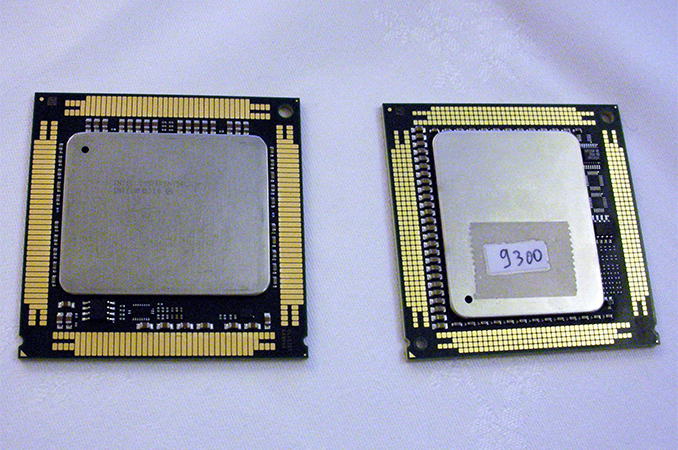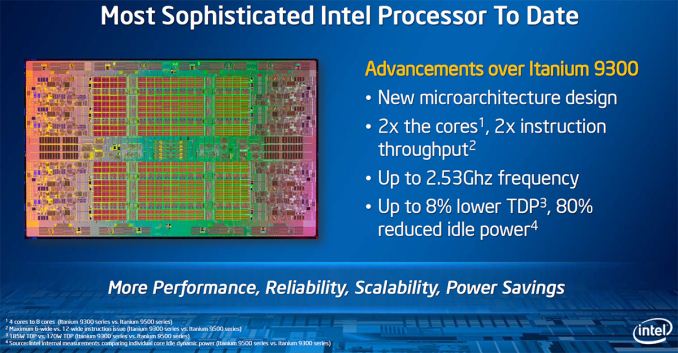Intel to Discontinue Itanium 9500 ‘Poulson’ CPUs
by Anton Shilov on March 8, 2018 6:00 PM EST
Intel has begun its product discontinuance program for its "Poulson" Itanium 9500-series processors. Intel’s customers will have to make their final orders for these CPUs this fall and the last Poulson chips will be shipped in early 2021.
Intel’s Itanium 9500-series lineup consists of four CPUs: the quad-core Itanium 9520 and 9550 as well as the eight-core Itanium 9540 and 9560. All of the these processors were released in Q4 2012, and were supplanted with the newer "Kittson" 9700 CPUs last year. Now Intel has set the entire Poulson family to discontinued in Q1 2021, a little more than eight years after their release.
Intel’s customers are advised to place their orders on Itanium 9500-series processors by September 17, 2018. Orders will become non-cancelable on September 28, 2018. The final Poulson chips will be shipped by March 5, 2021. Keep in mind that HP Enterprise (the only company that uses Itanium) will cease selling servers based on the Itanium 9500-series on March 31, 2018, so demand for Poulson products is not going to be high in the coming years.
Intel’s Poulson processor (pictured above on the right, image by Silicon.fr) was among the most significant microarchitectural and performance advancements of the Itanium products throughout their history: the CPU doubled issue width to 12 instructions per cycle, got 4-way Hyper-Threading, received higher frequencies, as well as up to eight cores. By contrast, Intel’s latest Itanium 9700-series processors run only slightly faster than the highest-end 9500-series chips.
The retirement of the Poulson family will mean that Intel's 9700 processors will be the only Itanium parts on the market – and indeed they will be the last Itanium processors altogether as Intel has ceased further Itanium development. Meanwhile only a single vendor – long-time Itanium partner HP Enterprise – is still selling Itanium-based servers. But even so, expect Itanium machines to be around for years to come; HPE’s Integrity machines are used primarily for mission- and business-critical applications, where customers are invested into the platform for the very long term.
Related Reading:
- Intel’s Itanium Takes One Last Breath: Itanium 9700 Series CPUs Released
- Intel to Release New Itanium CPUs in 2012: New Architecture and Up to Eight Cores
Image Source: Silicon.fr
Source: Intel











27 Comments
View All Comments
Threska - Saturday, March 10, 2018 - link
Could have saved Intel from MELTDOWN.SarahKerrigan - Thursday, March 8, 2018 - link
"got 4-way Hyper-Threading"No it didn't. What it got was "dual-domain multithreading," which isn't the same thing, but was rather part of Poulson's somewhat decoupled frontend and backend shift. In terms of visible threads, it remained two-per-core SoEMT, just like every other IPF core since Montecito.
Dragonstongue - Thursday, March 8, 2018 - link
everything has a time for it to "end"seems they (Intel) push as little boundaries as possible to stay relevant and instead do the minimal amount possible to ensure continued sales, makes me wonder what the high tech industry will look like in 2021-2025 type deal, make me wonder even more had Intel NOT shafted AMD the way they did for as many years they did (and still do to a point) how substantial the computing power we would now be enjoying rather than the small 1/2 step forward every once in awhile we have been seeing the past decade or so (chips are wicked fast vs what used to be granted, but they also seem to only be pushing very small steps ahead per annum realistically speaking)
They ALL should be more like mobile design concept, use the least amount of power possible and get the absolute performance that can be achieved, can always jump die size or ramp clock speeds after they fine tune for lowest potential power use (especially the average and sustained clock/power many seem to forget about)
VLIW was used at least from what I know about more on a consumer level with Radeons up to the 6900 series VLIW 4, previous was VLIW 5 (I believe GCN still is very akin to the principle though not quite talked about as such) they had a crap ton of performance available IF the software was to take advantage of it, but, like anything it seems devs etc will use the least amount of work possible to get things going, or we would not be needing gpu/cpu with access to many gb of memory and thousands of shaders in the first place ^.^
Flunk - Thursday, March 8, 2018 - link
They could discontinue these tomorrow and very few people would care. It's those enterprise availability contracts keeping it going even this long.Sivar - Friday, March 9, 2018 - link
Itanium is still the only game in town for running VMS, at least until the VMS port to AMD64 is complete.Kevin G - Saturday, March 10, 2018 - link
Well there is Alpha is you want to use even more dated hardware.Johan Steyn - Friday, March 16, 2018 - link
Amazing to still hear about these Itanics. This was probably the mostly costly fail in the history of tech.